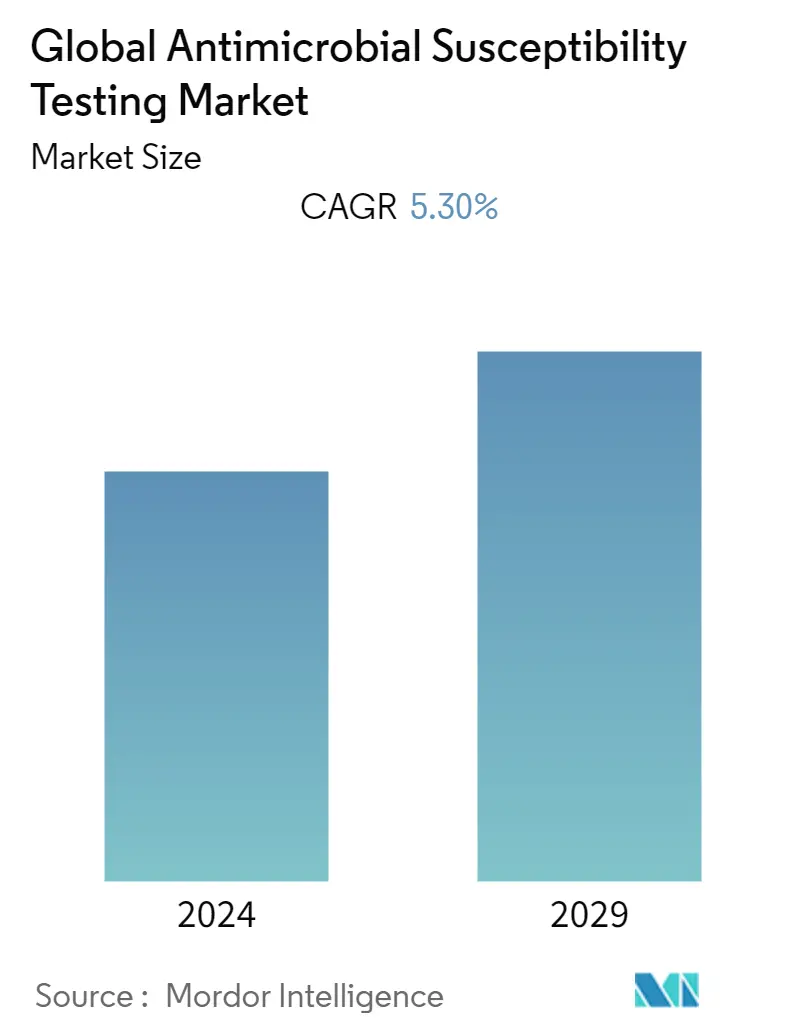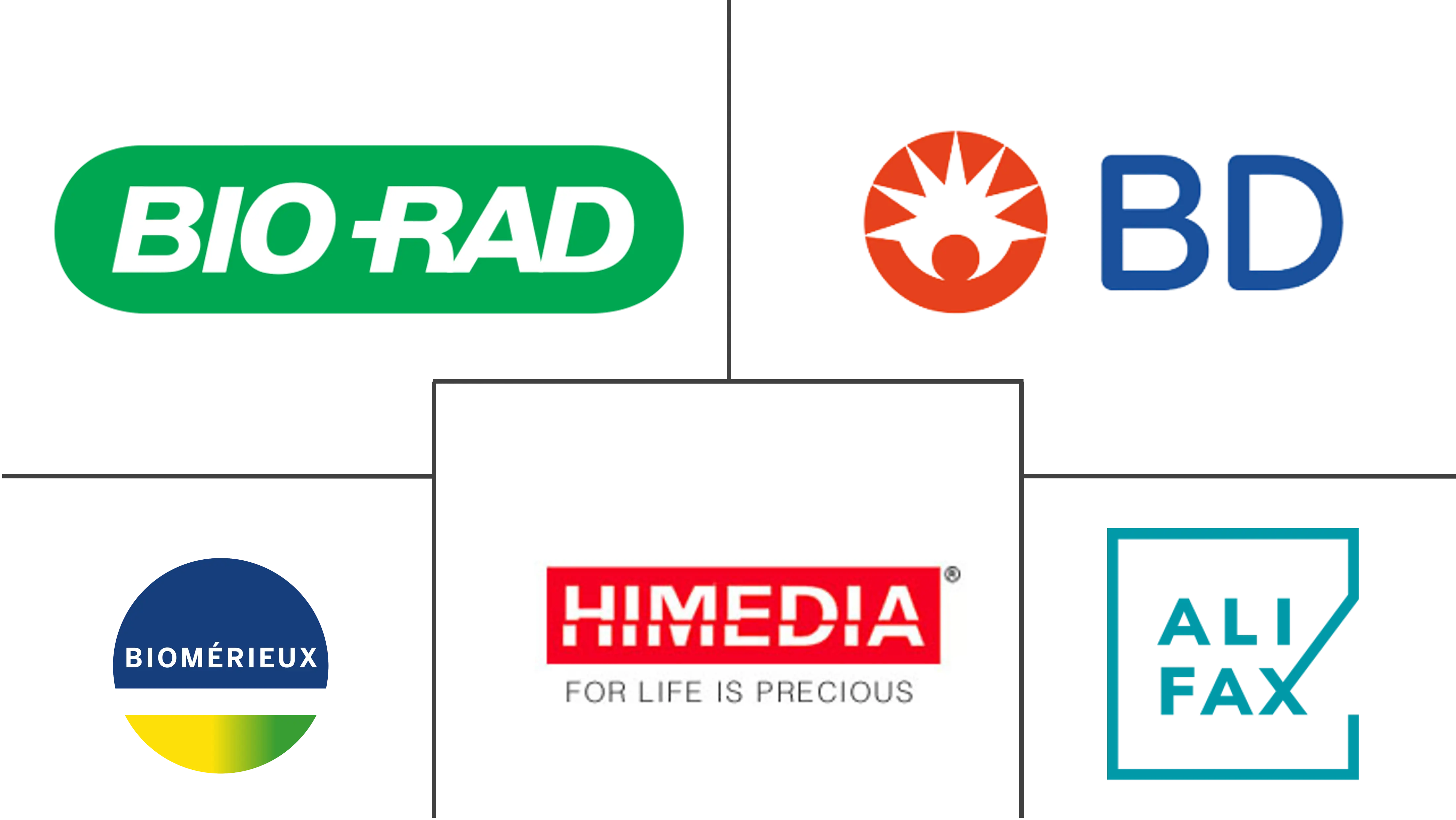Market Size of Global Antimicrobial Susceptibility Testing Industry

| Study Period | 2019 - 2029 |
| Base Year For Estimation | 2023 |
| CAGR | 5.30 % |
| Fastest Growing Market | Asia-Pacific |
| Largest Market | North America |
| Market Concentration | Low |
Major Players
*Disclaimer: Major Players sorted in no particular order |
Antimicrobial Susceptibility Testing Market Analysis
The antimicrobial susceptibility testing market is poised to grow at a CAGR of 5.3% over the forecast period (2022-2027).
Globally, COVID-19 has a significant and unprecedented impact on the supply of healthcare and public health across several nations. As per the article published in 2021 under the title 'Antimicrobial susceptibility patterns of respiratory Gram-negative bacterial isolates from COVID-19 patients in Switzerland', the development of bacterial superinfections in ventilated COVID-19 patients impacted by high levels of antimicrobial resistance, which in some situations necessitate continued modification of antibiotic therapy. Furthermore, the article published in 2021 under the heading 'Impact of the COVID-19 pandemic on the surveillance, prevention, and control of antimicrobial resistance: a global survey' stated that health systems have been significantly impacted by the COVID-19 pandemic. COVID-19's impacts on antimicrobial resistance surveillance, prevention, and control were investigated by the World Health Organization (WHO) Antimicrobial Resistance (AMR) Surveillance and Quality Assessment Collaborating Centers Network. Hence due to the aforementioned factors, COVID-19 had a significant impact on the market studied.
The major factors attributing to the growth of the market are the increasing prevalence of multidrug-resistant organisms and growing awareness of precision medicine. According to the Centers for Disease Control and Prevention (CDC), more than 2.8 million antibiotic-resistant infections happen in the United States every year. The increasing number of multidrug-resistant diseases increases the need for antimicrobial susceptibility testing. The rising awareness programs and initiatives for personalized medicine have a positive effect on the growth of the market and the other factor which is playing a pivotal role in taking the antimicrobial susceptibility testing market to the next level is increasing the use of the tests by the pharmaceutical companies. For instance, WHO celebrates World Antimicrobial Awareness Week (WAAW) from 18-24 November every year. The 2021 theme was Spread Awareness, Stop Resistance, which called on One Health stakeholders, policymakers, health care providers, and the public to be Antimicrobial Resistance (AMR) Awareness champions.
Hence as per the information mentioned above, the antimicrobial susceptibility testing market is expected to witness growth over the forecast period. However, stringent regulatory government policies and the challenges associated with antimicrobial susceptibility testing are expected to restrain the growth of the market over the forecast period.
Antimicrobial Susceptibility Testing Industry Segmentation
As per the scope of the report, antimicrobial susceptibility testing (AST), is a laboratory process, to determine which antimicrobial regimen is specifically beneficial for each patient. Antibiotic susceptibility tests are used to identify the exact antibiotics that a certain strain of bacteria or fungus is susceptible to. The results of a Gram stain and culture, which are often obtained considerably more quickly, are commonly supplemented by this testing. The Antimicrobial Susceptibility Testing Market is segmented by Products (Manual Antimicrobial Susceptibility Testing, Automated Antimicrobial Susceptibility Testing Products, Consumables), Type (Antibacterial Testing, Antifungal Testing, Antiparasitic Testing, Others), By Application (Diagnostics, Drug Discovery, and Development, Epidemiology, Others) and Geography (North America, Europe, Asia-Pacific, Middle East, and Africa, and South America). The market report also covers the estimated market sizes and trends for 17 countries across major regions globally. The report offers the value (in USD million) for the above segments.
| By Product | |||||
| |||||
| Automated Antimicrobial Susceptibility Testing Products | |||||
| Consumables |
| By Type | |
| Antibacterial Testing | |
| Antifungal Testing | |
| Antiparasitic Testing | |
| Others |
| By Application | |
| Diagnostics | |
| Drug Discovery and Development | |
| Epidemiology | |
| Others |
| Geography | ||||||||
| ||||||||
| ||||||||
| ||||||||
| ||||||||
|
Global Antimicrobial Susceptibility Testing Market Size Summary
The antimicrobial susceptibility testing market is experiencing growth driven by the increasing prevalence of multidrug-resistant organisms and heightened awareness of precision medicine. The COVID-19 pandemic has significantly impacted the market, influencing antimicrobial resistance patterns and necessitating ongoing adjustments in antibiotic therapy for ventilated patients. The rising incidence of antibiotic-resistant infections, particularly in regions like North America, underscores the critical need for effective antimicrobial susceptibility testing. Government initiatives and awareness programs, such as the World Antimicrobial Awareness Week, are pivotal in promoting understanding and combating antimicrobial resistance. These efforts, coupled with the growing use of susceptibility tests by pharmaceutical companies, are expected to propel market expansion despite challenges posed by stringent regulatory policies.
The market is characterized by moderate competition, with key players like bioMérieux, Bio-Rad Laboratories, and Becton Dickinson focusing on technological advancements and new product launches to enhance their market presence. North America is anticipated to maintain its dominance due to the high incidence of antibiotic-resistant infections and robust government support. Initiatives such as the CDC's AR Solutions Initiative and the White House's National Action Plan are instrumental in addressing antimicrobial resistance and fostering market growth. The development of innovative technologies, such as those showcased by Qualigen Therapeutics and COPAN Diagnostics, further highlights the dynamic nature of the market, aiming to improve the efficiency and accuracy of antimicrobial susceptibility testing.
Global Antimicrobial Susceptibility Testing Market Size - Table of Contents
-
1. MARKET DYNAMICS
-
1.1 Market Overview
-
1.2 Market Drivers
-
1.2.1 Increasing Prevalence of Multi Drug Resistance Organisms
-
1.2.2 Rising Use of Antimicrobial Susceptibility Testing by Pharmaceutical Companies
-
1.2.3 Growing Awareness of Precision Medicine
-
-
1.3 Market Restraints
-
1.3.1 Stringent Government Regulatory Policies
-
1.3.2 Challenges associated with Antimicrobial Susceptibility Testing
-
-
1.4 Porter's Five Force Analysis
-
1.4.1 Threat of New Entrants
-
1.4.2 Bargaining Power of Buyers/Consumers
-
1.4.3 Bargaining Power of Suppliers
-
1.4.4 Threat of Substitute Products
-
1.4.5 Intensity of Competitive Rivalry
-
-
-
2. MARKET SEGMENTATION (Market Size by Value - USD Million)
-
2.1 By Product
-
2.1.1 Manual Antimicrobial Susceptibility Testing
-
2.1.1.1 MIC strips
-
2.1.1.2 Susceptibility Plates
-
2.1.1.3 Others
-
-
2.1.2 Automated Antimicrobial Susceptibility Testing Products
-
2.1.3 Consumables
-
-
2.2 By Type
-
2.2.1 Antibacterial Testing
-
2.2.2 Antifungal Testing
-
2.2.3 Antiparasitic Testing
-
2.2.4 Others
-
-
2.3 By Application
-
2.3.1 Diagnostics
-
2.3.2 Drug Discovery and Development
-
2.3.3 Epidemiology
-
2.3.4 Others
-
-
2.4 Geography
-
2.4.1 North America
-
2.4.1.1 United States
-
2.4.1.2 Canada
-
2.4.1.3 Mexico
-
-
2.4.2 Europe
-
2.4.2.1 Germany
-
2.4.2.2 United Kingdom
-
2.4.2.3 France
-
2.4.2.4 Italy
-
2.4.2.5 Spain
-
2.4.2.6 Rest of Europe
-
-
2.4.3 Asia Pacific
-
2.4.3.1 China
-
2.4.3.2 Japan
-
2.4.3.3 India
-
2.4.3.4 Australia
-
2.4.3.5 South Korea
-
2.4.3.6 Rest of Asia-Pacific
-
-
2.4.4 Middle East and Africa
-
2.4.4.1 GCC
-
2.4.4.2 South Africa
-
2.4.4.3 Rest of Middle East and Africa
-
-
2.4.5 South America
-
2.4.5.1 Brazil
-
2.4.5.2 Argentina
-
2.4.5.3 Rest of South America
-
-
-
Global Antimicrobial Susceptibility Testing Market Size FAQs
What is the current Global Antimicrobial Susceptibility Testing Market size?
The Global Antimicrobial Susceptibility Testing Market is projected to register a CAGR of 5.30% during the forecast period (2024-2029)
Who are the key players in Global Antimicrobial Susceptibility Testing Market?
Bio-Rad Laboratories, Inc, HiMedia Laboratories, Alifax, bioMérieux SA and Becton Dickinson, and Company are the major companies operating in the Global Antimicrobial Susceptibility Testing Market.

